|
View: 2146|Reply: 4
|
[Pelbagai]
Comic Books...RIP Stan Lee...in cameos...
[Copy link]
|
|
|
Edited by seribulan at 13-11-2018 08:51 AM
Comics: Comic Books
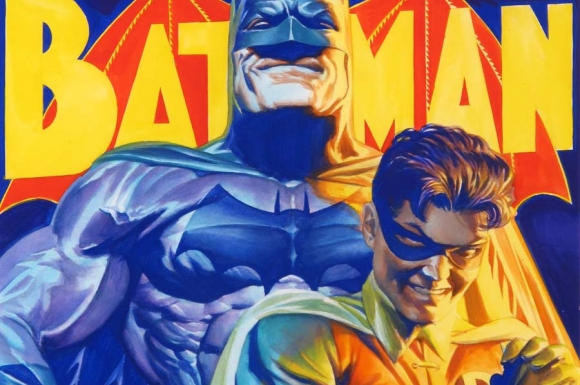 Description Description
The precursor to comic books, cartoons have been popular in England and America since the early 1800s, originating as satirical and political cartoons printed in newspapers and periodicals. The most influential cartoonist of this period, Thomas Nast played a large role in bringing down “Boss” Tweed’s corrupt political machine in 1870s New York through a series of cartoons heavily critical of Tweed. Through a natural evolution, cartoons developed into comic books, first through publications containing compilations of cartoon re-prints, then as books with original cartoon artwork, before reaching critical mass through the creation of superheroes in 1938.
]Platinum Age
Published in 1897, The Yellow Kid in McFadden’s Flats is considered to be the first comic book, insomuch that it bore the phrase “comic book” on its back cover. Far from the full-color glossy comic books of today, this book featured black and white reprints of popular newspaper comic strips. Subsequent comic strip compilation books included reprints of The Katzenjammer Kids, Happy Hooligan, Buster Brown, and Mutt & Jeff. [size=0.875em]The first monthly comic book, aptly titled Comics Monthly, began publication in 1922, though it also featured reprints of daily newspaper comic strips. In 1933, Funnies On Parade became the first color comic book printed in the now standard size of 6 5/8 x 10 1/4 inches.
In February 1935, DC Comics’ precursor, National Allied Publications, published New Fun#1—the company’s first comic book and the first ever comic book consisting of completely original material. Jerry Siegel and Joe Shuster, soon to be known for creating Superman, began working on New Fun in October 1935. In the March 1937 edition of Detective Comics #1, Siegel and Shuster introduced their character Slam Bradley, the forebear of Superman.
Golden Age 1938-1956
The Golden Age of Comic Books began in June 1938 with the debut of Superman inAction Comics #1. Batman premiered less than a year later in Detective Comics #27.
In October 1939, Marvel Comics’ predecessor, Timely Publications, released Marvel Comics #1 which included the Human Torch, Angel, and Prince Namor the Sub-Mariner. Along with Fawcett Comics’ superhero Captain Marvel, DC Comics’ Flash and Green Lantern debuted in 1940. Marvel’s Captain America and DC’s Wonder Woman were first published the following year. [size=0.875em]The period from 1938 through the mid-1940s represents the peak of comic book popularity. Whereas current monthly sales of popular comic book titles hover around 100,000 copies, in the early 1940s Superman, Batman and Captain Marvel titles each regularly sold in the range of 1.5 million copies per month.
During the return to normalcy in post-war America, superhero comic books sales plummeted and many titles ceased publication. Through the mid-1950s, the void was filled by comic books containing more serious themes such as crime, romance, Western, and horror. However, through this period comic books based on the Superman, Batman, and Wonder Woman characters retained a modest audience.
Silver Age
1956-1970
In 1954, psychiatrist Fredric Wertham wrote in his bestselling book Seduction of the Innocent that comic books of all types were corrupting the youth of America. Wertham posited that Superman represented fascist ideals, Batman and Robin promoted a homosexual lifestyle, and Wonder Woman was a lesbian with a bondage fixation. Members of Congress were so alarmed that they called Wertham to testify before the Senate Subcommittee on Juvenile Delinquency. [size=0.875em]Sensing public backlash, that same year comic book publishers created the Comics Code Authority in order to self-regulate their industry, much as the Motion Picture Association of America was formed to prevent government involvement in film production. The Code set a number of requirements for comic books:
“In every instance good shall triumph over evil…” “If crime is depicted it shall be as a sordid and unpleasant activity.” “Females shall be drawn realistically without exaggeration of any physical qualities.” “…vampires and vampirism, ghouls, cannibalism and werewolfism are prohibited.”
Subsequently cancelling many horror, crime, and romance titles which violated the Code, comic book companies began publishing comic books featuring superheroes from the Golden Age. They revamped existing superheroes and created new superhero characters. The return of Flash, albeit an updated version of Flash, in Showcase #4 (October 1956) marks the beginning of the Silver Age, when superhero comic books saw a renewed commercial success.
The late 1950s through the 1960s saw a change from dark and supernatural comic book themes to the other end of the spectrum with books containing silly plots and a high degree of camp. Such plots involved Superbaby and “The Super-Monkey from Krypton” in Superboy #76 (October 1959) and Batman and Robin teaming up with comedian Jerry Lewis to fight the Joker in Jerry Lewis #97 (December 1966).
Heralding the outrageousness of the Batman television series in the mid-1960s, Batman comic books introduced ridiculous characters such as Batbaby, Bat-Ape, Bat-Mite, and Ace the Bat Hound. Also during this time, taking the place of serious villains to battle Superman, numerous forms of kryptonite were brought forth—gold, blue, Jewel, red-green, Magno, red-gold kryptonite and Kryptonite Plus.
Bronze Age
1970-1985
The Bronze Age signaled a more realistic style within comic books as a younger generation of artists, including Neal Adams, John Byrne, George Perez, Frank Miller, and others, replaced aging artists who had helped to create the superhero comic books of the 1930s and 1940s. [size=0.875em]The beginning of the Bronze Age of comic books is marked by the shocking murder of Peter Parker’s girlfriend Gwen Stacy at the hands of the Green Goblin in Amazing Spider-Man #121-122 (June-July 1973). In a genre where heroes are relied upon to surmount almost any challenge, it was revolutionary to illustrate the brutal murder of an innocent character alongside the ultimate failure of her anticipated savior. [size=0.875em]In 1971, the Comics Code Authority relaxed some standards, going so far as to state, “Vampires, ghouls, and werewolves shall be permitted to be used when handled in the classic tradition …”
This more lenient attitude allowed for the return of the horror comic genre, including titles such as The Tomb of Dracula in 1972 and Ghost Rider and Tales of the Zombie in 1973. Additional supernatural characters Man-Bat, Swamp Thing, and Blade were introduced in the early 1970s.
In addition, socially conscious stories became more numerous in the 1970s, most famously during the collaborative adventures of Green Lantern and Green Arrow as they fought against racism, pollution, and social injustice. Green Arrow also confronted his sidekick Speedy’s heroin addiction while Iron Man came to terms with his alcoholism.
Understanding that a vast majority of their superheroes were Caucasian men, DC and Marvel introduced a slew of minority superheroes such as Storm, Black Lightning, Blade, and the Green Lantern John Stewart.
Dark Age
1985-1996
Kicking off the Dark Age of comic books was the publication of the monumental seriesCrisis on Infinite Earths. To commemorate DC Comics’ 50th anniversary, DC publishedCrisis on Infinite Earths as a 12-issue comic book event. In this series, DC planned to clear up decades of plot inconsistencies, as well as bring together conflicting characters from the Golden Age and the Silver Age. The idea was to have multiple alternate realities brought together to make one consistent reality, as in reconciling how Green Lantern Alan Scott from the 1940s can exist in the same reality as Green Lantern Hal Jordan of the 1960s. To wit, the Justice Society of the 1940s (with their Green Lantern) could exist at the same time as the Justice League of the 1960s (with a different Green Lantern). To solve some of the inconsistencies, certain major characters were killed off and characters long out of play were brought back with new storylines. Ultimately Crisis on Infinite Earths was a major success for DC Comics. [size=0.875em]From the mid-1980s through the early 1990s, anti-heroes were popular. Dark, pessimistic stories reigned, as in Alan Moore’s Watchmen, where a world looks down on once mighty superheroes or in Frank Miller’s Batman: The Dark Knight Returns where a 55-year-old Batman has retired from crime-fighting, leaving criminals to terrorize Gotham City. Readers witnessed Superman dying, Batman becoming critically injured, and Green Lantern Hal Jordan slaughtering his fellow Green Lanterns.
The Dark Age also saw the publication of the Pulitzer Prize-winning Maus, Art Spiegelman’s moving, autobiographical tale of a Jewish family in Poland living through the reign of Nazi Germany.
This period ends with a massive sales slump and industry downsizing caused by a speculator’s market where excess merchandise, too many collector’s editions, and too many series were produced in an inflated market. The sales slump contributed to the bankruptcy of Marvel Comics in 1996.
Modern Age
1996-Present
The publication of Alex Ross’s Kingdom Come in 1996, which harkened back to the optimism and strength of Silver Age superheroes, marks the beginning of the Modern Age. During this period, comic book publishers attempted to rectify their mistakes by creating a leaner business plan and putting more effort into a fewer number of projects. Following the dismal failure of the motion picture Batman and Robin (1997), superhero films were put on ice for retooling. In 2000, the modest success of The X-Menhelped put the popularity of the superhero movie back on track. [size=0.875em]Over eighty years since the debut of Superman, the comic book industry has remained relevant through the early adoption of digital comics, successful saturation into the film and television markets, and maintaining a strong connection to their fan-base.
Jesse Kowalski, Curator of Exhibitions, Norman Rockwell Museum
|
Rate
-
1
View Rating Log
-
|
|
|
|
|
|
|
|
|
|
|
NOVEMBER 12, 2018
10:47am PT by Mike Barnes
Stan Lee, Marvel Comics' Real-Life Superhero, Dies at 95
Play Video
The feisty writer, editor and publisher was responsible for such iconic characters as Spider-Man, the X-Men, Thor, Iron Man, Black Panther and the Fantastic Four — 'nuff said.
Stan Lee, the legendary writer, editor and publisher of Marvel Comics whose fantabulous but flawed creations made him a real-life superhero to comic book lovers everywhere, has died. He was 95.
Lee, who began in the business in 1939 and created or co-created Black Panther, Spider-Man, the X-Men, the Mighty Thor, Iron Man, the Fantastic Four, the Incredible Hulk, Daredevil and Ant-Man, among countless other characters, died early Monday morning at Cedars-Sinai Medical Center in Los Angeles, a family representative told The Hollywood Reporter.
Kirk Schenck, an attorney for Lee's daughter, J.C. Lee, also confirmed his death.
Lee's final few years were tumultuous. After Joan, his wife of 69 years, died in July 2017, he sued executives at POW! Entertainment — a company he founded in 2001 to develop film, TV and video game properties — for $1 billion alleging fraud, then abruptly dropped the suit weeks later. He also sued his ex-business manager and filed for a restraining order against a man who had been handling his affairs. (Lee's estate is estimated to be worth as much as $70 million.) And in June 2018, it was revealed that the Los Angeles Police Department had been investigating reports of elder abuse against him.
On his own and through his work with frequent artist-writer collaborators Jack Kirby, Steve Ditko and others, Lee catapulted Marvel from a tiny venture into the world's No. 1 publisher of comic books and, later, a multimedia giant.
In 2009, The Walt Disney Co. bought Marvel Entertainment for $4 billion, and most of the top-grossing superhero films of all time — led by Avengers: Infinity War's $2.05 billion worldwide take earlier this year — have featured Marvel characters.
"I used to think what I did was not very important," he told the Chicago Tribune in April 2014. "People are building bridges and engaging in medical research, and here I was doing stories about fictional people who do extraordinary, crazy things and wear costumes. But I suppose I have come to realize that entertainment is not easily dismissed."
Lee's fame and influence as the face and figurehead of Marvel, even in his nonagenarian years, remained considerable.
READ MORE
How Stan Lee Broke Down the Barrier Between Audience and Artist
“Stan Lee was as extraordinary as the characters he created," Disney chairman and CEO Bob Iger said in a statement. "A superhero in his own right to Marvel fans around the world, Stan had the power to inspire, to entertain and to connect. The scale of his imagination was only exceeded by the size of his heart."
Marvel Studios president Kevin Feige also paid tribute. “No one has had more of an impact on my career and everything we do at Marvel Studios than Stan Lee," Feige said. "Stan leaves an extraordinary legacy that will outlive us all. Our thoughts are with his daughter, his family and the millions of fans who have been forever touched by Stan’s genius, charisma and heart.”
Beginning in the 1960s, the irrepressible and feisty Lee punched up his Marvel superheroes with personality, not just power. Until then, comic book headliners like those of DC Comics were square and well-adjusted, but his heroes had human foibles and hang-ups; Peter Parker/Spider-Man, for example, fretted about his dandruff and was confused about dating. The evildoers were a mess of psychological complexity.
"His stories taught me that even superheroes like Spider-Man and the Incredible Hulk have ego deficiencies and girl problems and do not live in their macho fantasies 24 hours a day," Gene Simmons of Kiss said in a 1979 interview. "Through the honesty of guys like Spider-Man, I learned about the shades of gray in human nature."
(Kiss made it to the Marvel pages, and Lee had Simmons bleed into a vat of ink so the publisher could say the issues were printed with his blood.)
The Manhattan-born Lee wrote, art-directed and edited most of Marvel's series and newspaper strips. He also penned a monthly comics column, “Stan's Soapbox,” signing off with his signature phrase, “Excelsior!”
His way of doing things at Marvel was to brainstorm a story with an artist, then write a synopsis. After the artist drew the story panels, Lee filled in the word balloons and captions. The process became known as “The Marvel Method.”
Lee collaborated with artist-writer Kirby on the Fantastic Four, Hulk, Iron Man, Thor, Silver Surfer and X-Men. With artist-writer Ditko he created Spider-Man and the surgeon Doctor Strange, and with artist Bill Everett came up with the blind superhero Daredevil.
READ MORE
Stan Lee Needs a Hero: Elder Abuse Claims and a Battle Over the Aging Marvel Creator
Such collaborations sometimes led to credit disputes: Lee and Ditko reportedly engaged in bitter fights, and both receive writing credit on the Spider-Man movies and TV shows. "I don't want anyone to think I treated Kirby or Ditko unfairly," he told Playboy magazine in April 2014. "I think we had a wonderful relationship. Their talent was incredible. But the things they wanted weren't in my power to give them."
Like any Marvel employee, Lee had no rights to the characters he helped create and received no royalties.
In the 1970s, Lee importantly helped push the boundaries on censorship in comics, delving into serious and topical subject matter in a medium that had become mindless, kid-friendly entertainment.
In 1954, the publication of psychologist Frederic Wertham's book Seduction of the Innocent had spurred calls for the government to regulate violence, sex, drug use, questioning of public authority figures, etc., in the comics as a way to curtail "juvenile delinquency." Wary publishers headed that off by forming the Comics Code Authority, a self-censoring body that while avoiding the heavy hand of Washington still wound up neutering adult interest in comics and stereotyping the medium as one only kids would enjoy.
Lee scripted banal scenarios with characters like Nellie the Nurse and Tessie the Typist, but in 1971, he inserted an anti-drug storyline into "The Amazing Spider-Man” in which Peter Parker's best friend Harry Osborn popped pills. Those issues, which did not carry the CCA "seal of approval" on the covers, became extremely popular, and later, the organization relaxed some of its guidelines.
Born Stanley Martin Lieber on Dec. 28, 1922, he grew up poor in Washington Heights, where his father, a Romanian immigrant, was a dress-cutter. A lover of adventure books and Errol Flynn movies, Lee graduated from DeWitt Clinton High School, joined the WPA Federal Theatre Project, where he appeared in a few stage shows, and wrote obituaries.
In 1939, Lee got a job as a gofer for $8 a week at Marvel predecessor Timely Comics. Two years later, for Kirby and Joe Simon's Captain America No. 3, he wrote a two-page story titled "The Traitor's Revenge!" that was used as text filler to qualify the company for the inexpensive magazine mailing rate. He used the pen name Stan Lee.
He was named interim editor at 19 by publisher Martin Goodman when the previous editor quit. In 1942, he enlisted in the Army and served in the Signal Corps, where he wrote manuals and training films with a group that included Oscar-winner Frank Capra, Pulitzer-winner William Saroyan and Theodor Geisel (aka Dr. Seuss). After the war, he returned to the publisher and served as the editor for decades.
Following DC Comics' lead with the Justice League, Lee and Kirby in November 1961 launched their own superhero team, the Fantastic Four, for the newly renamed Marvel Comics, and Hulk, Spider-Man, Doctor Strange, Daredevil and X-Men soon followed. The Avengers launched as its own title in September 1963.
Perhaps not surprisingly, Manhattan's high-literary culture vultures did not bestow its approval on how Lee was making a living. People would “avoid me like I had the plague. … Today, it's so different,” he once told The Washington Post.
Not everyone felt the same way, though. Lee recalled once being visiting in his New York office by Federico Fellini, who wanted to talk about nothing but Spider-Man.
In 1972, Lee was named publisher and relinquished the Marvel editorial reins to spend all his time promoting the company. He moved to Los Angeles in 1980 to set up an animation studio and to build relationships in Hollywood. Lee purchased a home overlooking the Sunset Strip that was once owned by Jack Benny's announcer, Don Wilson.
Long before his Marvel characters made it to the movies, they appeared on television. An animated Spider-Man show (with a memorable theme song composed by Oscar winner Paul Francis Webster, of "The Shadow of Your Smile" fame, and Bob Harris) ran on ABC from 1967 to 1970. Bill Bixby played Dr. David Banner, who turns into a green monster (Lou Ferrigno) when he gets agitated, in the 1977-82 CBS drama The Incredible Hulk. And Pamela Anderson provided the voice of Stripperella, a risque animated Spike TV series that Lee wrote for in 2003-04.
Lee launched the internet-based Stan Lee Media in 1998, and the superhero creation, production and marketing studio went public a year later. However, when investigators uncovered illegal stock manipulation by his partners, the company filed for Chapter 11 bankruptcy protection in 2001. (Lee was never charged.)
In 2002, Lee published an autobiography, Excelsior! The Amazing Life of Stan Lee.
Survivors include his daughter and younger brother Larry Lieber, a writer and artist for Marvel. Another daughter, Jan, died in infancy. His wife, Joan, was a hat model whom he married in 1947.
"J.C. Lee and all of Stan Lee's friends and colleagues want to thank all of his fans and well-wishers for their kind words and condolences," a family statement read. "Stan was an icon in his field. His fans loved him and his desire to interact with them. He loved his fans and treated them with the same respect and love they gave him."
"He worked tirelessly his whole life creating great characters for the world to enjoy. He wanted to inspire our imagination and for us to all use it to make the world a better place. His legacy will live on forever."
Like Alfred Hitchcock before him, the never-bashful Lee appeared in cameos in the Marvel movies, shown avoiding falling concrete, watering his lawn, delivering the mail, crashing a wedding, playing a security guard, etc.
In Spider-Man 3 (2007), he chats with Tobey Maguire's Peter Parker as they stop on a Times Square street to read news that the web-slinger will soon receive the key to the city. “You know," he says, "I guess one person can make a difference … 'nuff said.”
Duane Byrge and Borys Kit contributed to this report.
Ps. Baya ayah saya ni... |
Rate
-
1
View Rating Log
-
|
|
|
|
|
|
|
|
|
|
|
Edited by seribulan at 13-11-2018 08:50 AM
|
|
|
|
|
|
|
|
|
|
|
|
- The Amazing Spider-Man, 2012Credited as School librarian
FacebookTwitterPinterest

Iron Man 3, 2013Credited as Pageant judge
FacebookTwitterPinterest
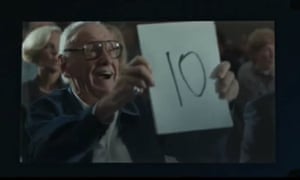
Thor: The Dark World, 2013Credited as Patient in mental ward
FacebookTwitterPinterest
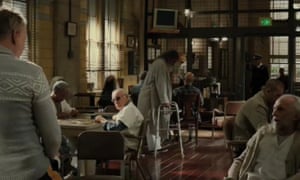
Captain America: Winter Soldier, 2014Credited as Smithsonian guard
FacebookTwitterPinterest
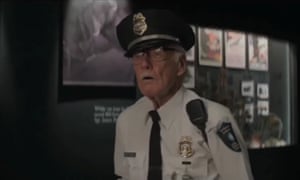
The Amazing Spider-Man 2, 2014Credited as Graduation guest
FacebookTwitterPinterest
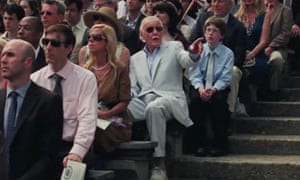
Guardians of the Galaxy, 2014Credited as Xandarian ladies man
FacebookTwitterPinterest

Avengers Age of Ultron, 2015Credited as War veteran
FacebookTwitterPinterest

Ant-Man, 2015Credited as Bartender
FacebookTwitterPinterest
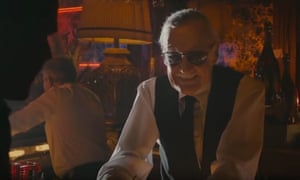
Deadpool, 2016Credited as Strip Club DJ
FacebookTwitterPinterest

Captain America: Civil War, 2016Credited as FedEx driverAll images © Marvel
FacebookTwitterPinterest
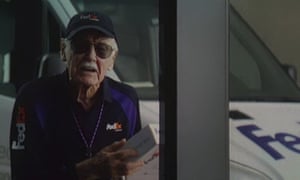
Black Panther, 2018
Photograph: Marvel
FacebookTwitterPinterest
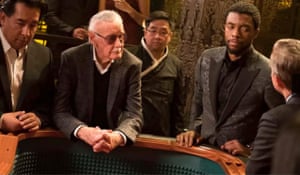
From X-Men to Deadpool: Stan Lee's Marvel movie cameos – in pictures
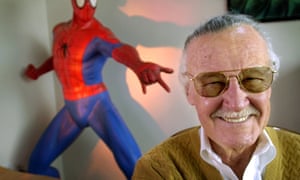
Marvel legend Stan Lee – a life in pictures
Published: 12 Nov 2018
|
Rate
-
1
View Rating Log
-
|
|
|
|
|
|
|
|
|
| |
Category: Belia & Informasi
|